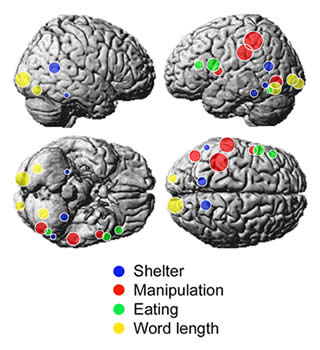Food, Shelter, and Big Words
Decades ago, Abraham Maslow proposed that humans had a hierarchy of needs, with food being at the most basic level of biological need and shelter one step above as part of a “safety” need. He may have been on the right track, according to new research led by Marcel Just at Carnegie Mellon University. The researchers exposed subjects to a series of nouns while monitoring their brain activity in an fMRI machine, and recorded which areas of the subjects brain were activated by each noun.
 What they found was fascinating: specific brain patterns emerged for nouns related to food, shelter, and “manipulation” (things that can be grasped or used). The paper’s abstract notes, “an individual concrete noun like apple can be identified with good accuracy from among 60 candidate words, using only the fMRI activity in the 16 locations associated with these factors.” Long words also caused different activation patterns than short ones.
What they found was fascinating: specific brain patterns emerged for nouns related to food, shelter, and “manipulation” (things that can be grasped or used). The paper’s abstract notes, “an individual concrete noun like apple can be identified with good accuracy from among 60 candidate words, using only the fMRI activity in the 16 locations associated with these factors.” Long words also caused different activation patterns than short ones.
Equally interesting was that the findings weren’t specific to individual subjects – all of the subjects’ brains seemed to be activated in a similar way, auguring well for the future of such research.
While this work’s neuromarketing utility may be mainly as a foundation for more specific studies in the future, I do think it is interesting to note the special treatment accorded the nouns in the food, shelter, manipulation, and “long” categories. Incorporating food/shelter words in one’s copy (when relevant and appropriate) may end up having a greater impact. This research doesn’t tell us that long words are less effective or harder for the brain to interpret, but I’d consider the fact that lengthy terms activate a different area of the brain to be at least a caution flag for their use in headlines or short copy.
Read the whole paper here: A Neurosemantic Theory of Concrete Noun Representation Based on the Underlying Brain Codes.
